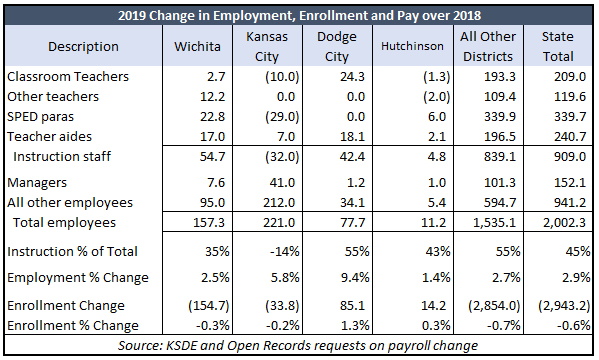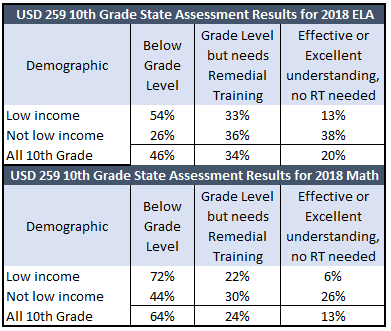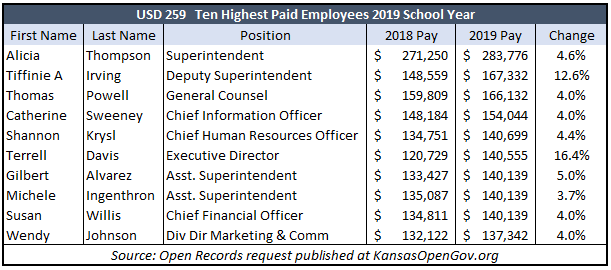Fearful that school districts wouldn’t allocate enough money to classrooms, legislators tried to add accountability measures to the school funding formula this year. Now it appears their fears were well-founded.
Personnel reports from the Kansas Department of Education show USD 259 Wichita allocated just a third of staff additions to classroom positions last year – about 15 teachers and 40 classroom aides – while adding over 100 non-classroom positions. Statewide, districts allocated 45% of new positions to classrooms but the plaintiff districts – Wichita, Kansas City, Dodge City, and Hutchinson – collectively allocated just 15% of staff additions to classrooms.

The Wichita district’s total payroll costs jumped 6% last year, based on Open Records request data published on KansasOpenGov.org. Total employment grew by 2.5% while enrollment slightly declined.
In terms of growth of staff certified clerical staff grew at more than double the rate of classroom teachers. For example, special educators grew 3.38%, while certified clerical staff grew 9.29%. Wendy Johnson the head of strategic communication for USD 259 feels the focus on percentage growth is does not take in account larger issues within the district.
“In the clerical area, there was an increase of 6 clerical personnel. Those individuals were in student support services (special education) in order to meet service expectations for our special education programs. In contrast, there were 21 additional teachers, primarily in special education,” said Johnson. The district’s personnel report, however, shows just 15 additional teachers, 12 of whom are in special education.
USD 259 also added 4 directors and 10 workers to their maintenance staff. 6 more people in technology, 12 people in foodservice, and 4 people classified as ‘other.’
When asked to clarify the differences between payroll and staffing increases, Johnson notes, “90% of the staffing increase you note is not actually more budgeted positions – it is filling the positions we had open more effectively. Likewise, about 90% of the increase in payroll shown here is simply having these budgeted positions filled.”
 Justifying new positions as already being on an organizational chart, however, doesn’t explain how staff additions will improve achievement – the purported purpose of suing taxpayers for more money.
Justifying new positions as already being on an organizational chart, however, doesn’t explain how staff additions will improve achievement – the purported purpose of suing taxpayers for more money.
Over half of 10th-grade students in USD 259 are below grade-level in math, according to the latest state assessment results, including 72% of the low-income students and 44% of other students. Only 6% of low-income students are on track to be ready for college and career, and just 26% of those who aren’t low-income.
As to how the increase in staffing increases impact student achievement the district responded with a link to a video highlighting the districts strategic plan. The video does not provide peer-reviewed or government data documenting how the increase in payroll will help with student achievement.
The ten highest-paid employees at USD 259 received an average pay increase of 6% last year, while inflation was 1.8%. Each person had the same title as the prior year.



